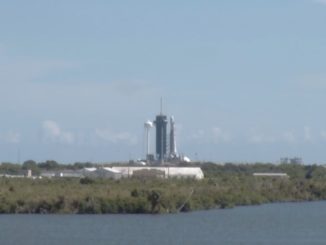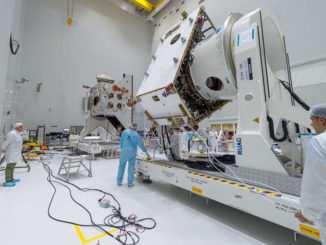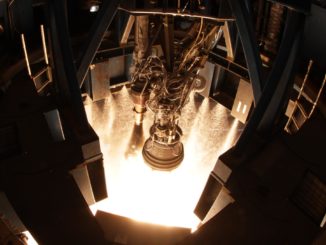
A modest privately-funded instrument package built by a company in Luxembourg became the first commercial to the moon to get off the ground with a fiery nighttime launch Thursday aboard a Chinese rocket.
The briefcase-sized spacecraft, fitted with a battery and a solar panel, a radio and a radiation detector, is riding piggyback on a Chinese technology demonstrator designed to verify technologies for a future mission to return lunar samples to Earth.
The mission lifted off Thursday from the Xichang satellite launch center in southwestern China’s Sichuan province, climbing into a night sky on top of a Long March 3C rocket.
The Chinese probe separated from the third stage of the Long March launcher, and the commercial payload remained attached to the rocket to ride around the moon and come back to earth on an eight-day round-trip journey.
Built by LuxSpaceX in Luxembourg, the instrument suite was put together in less than six months from the time officials approved the mission.
“This our speciality,” said Jochen Harms, managing director of LuxSpace. “We wanted to show that this was feasible. One of the ideas is really to show that you can do missions in quicker time and lower cost.”
LuxSpace developed the mission for approximately $500,000 entirely with private funding, Harms said.
The mission is named the Manfred Memorial Moon Mission, or M4, in memory of Manfred Fuchs, a pioneer in Europe’s commercial space sector who founded Bremen, Germany-based OHB — LuxSpace’s parent company — and grew it into leading satellite and rocket contractor.
Fuchs died in April, and LuxSpace gave the green light for the M4 mission in May.
China’s lunar probe, the prime payload on Thursday’s launch, will loop around the far side of the moon and return to Earth around Oct. 31, streaking through the atmosphere for a blazing-hot re-entry and touchdown in China’s Inner Mongolia autonomous region.
The third stage and its ride-along commercial payload could also plunge back to Earth and burn up in the atmosphere without a heat shield. But Harms said it is possible the rocket and LuxSpace’s mission — thanks to the propulsive effect of gravity — will wind up in a high-altitude orbit stretching 400,000 kilometers, or 250,000 miles, from Earth.
A late change to the launch trajectory by Chinese engineers made for a better chance the empty rocket stage and the M4 mission will be kicked into a long-term orbit rather than be consumed by fire in Earth’s atmosphere.
“If we’re lucky, we will continue to collect data from that orbit — radiation data and things like that,” Harms said.
LuxSpace responded to the launch adjustment from China by adding a solar panel to the M4 payload to recharge the package’s battery system, which was sufficient to power the mission on the flight to the moon and back.
“At the beginning we thought it would end with a 95 percent chance of burning in the Earth’s atmosphere, but when they changed, we put a solar panel on it,” Harms said in an interview with Spaceflight Now. “We had one here, so we just put it on.”
Harms said radiation data collected by the M4 mission on the way to the moon, and potentially from a distant unexplored orbit around Earth, will be openly shared and help design radiation shields and aid in navigation for future lunar missions.
“The idea is we will collect radiation information during the flight, and we have a rather simple but robust beacon transmitter on-board, and we think that we can use this type of beacon later on for other missions,” Harms said.
Signals from M4’s beacon received at different locations on Earth will allow LuxSpace to precisely locate the spacecraft’s location in space, officials said.
LuxSpace has posted information on how amateur radio operators can receive the beacon signals.
The mission’s accelerated timetable was by design, Harms said.
“The basic goal was to show that it’s possible to do a moon mission with simple means, and to do that outside the institutional framework and to do it quickly, “Harms said. “One major mission goal was to have a memorial to the founder of OHB.
“Usually with ESA and NASA missions, it can take many years from definition to launch, and I think you can do it much quicker,” Harms said. “We want to show that it’s possible to do valuable science with micro-probes. You don’t need a spacecraft that is thousands of kilograms.
“It’s interesting because it’s a more democratic approach to space than an agency-driven mission,” Harms said. “Of crouse big missions require the agencies, but we can now think about simple missions which may require less help from agencies… We have many scientists who highly appreciate the hopeful science return because they don’t have [this data] yet.”
The Google Lunar X Prize has offered $20 million to the first privately-funded team to put a mobile spacecraft on the lunar surface in a bid to foster commercial space transportation between Earth and the moon.
The M4 payload is roughly the size and shape of a briefcase, weighs about 10 kilograms (22 pounds) and runs on 6 watts of power.
The first signals from the craft’s transmitter were received in Brazil about 90 minutes after launch Thursday, according to LuxSpace.
“A very large number of radio amateurs has followed our request to acquire the data from the satellite,” said Marco Fuchs, CEO of OHB. “It is very encouraging to see so many people following our mission.”
Follow Stephen Clark on Twitter: @StephenClark1.



